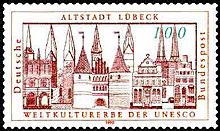Seven Towers (Lübeck)
The seven towers of the five main Gothic churches on the old town hill of the medieval Hanseatic city of Lübeck embody the cityscape that has become the city's landmark . The brick Gothic seven church towers of St. Jakobi , St. Marien , St. Petri , St. Aegidien and the Lübeck Cathedral have towered over the cityscape for centuries and are visible as a silhouette from afar from the entire surrounding area in Holstein and Mecklenburg . The highest of them, the pair of twin towers of the Marienkirche, rise around 125 m above the ground and thus around 150 m above the ground in the otherwise flat Holstein landscape . NN (for comparison: the highest elevation in Schleswig-Holstein, the Bungsberg in Ostholstein, is 168 m above sea level ).
In addition to the Holsten Gate, they are a symbol of the city and at the same time a brand that is also used by companies in Lübeck and the region.
The oldest representation of the Lübeck cityscape from 1481 can be found on an altar portrait by the Lübeck painter Hermen Rode in the Nikolaikirche in Tallinn . The concept of the seven towers is, however, a modern coin, as the old Lübeck cityscape still has eight towers on all images up to 1818 . This former church of the castle monastery , which stands north of the Jakobikirche and was consecrated to Maria Magdalena, was demolished in 1818 with the church. The panorama from the Pariner Berg , created around 1820 by the Swiss Johann Heinrich Bleuler, was probably one of the first depictions of the city with "only seven" towers. It ended up in the St. Anne's Museum in 1921.
The unique cityscape was designed in 1924 by the commercial artist Alfred Mahlau as a figurative mark for Schwartauer Werke , a manufacturer of jams and confectionery based in Bad Schwartau , and in 1943 he also incorporated it into the stamp 800 years Lübeck. The city of Lübeck itself also advertised the favor of tourists in the 50s and 60s with a graphic representation of the seven towers of Mahlau on brochures and posters. These posters have become coveted collector's items because of their artistic quality. Furthermore, the Sparkasse zu Lübeck uses the logo of the seven towers in its external appearance. They are one of the anchor points of all city marketing .
During the Second World War, all tower helmets except for the two from St. Aegidien and St. Jakobi were lost in the air raid on Lübeck on March 29, 1942 . Their wooden roof trusses burned like torches. The reconstruction of the destroyed five spiers, for which the roof trusses were no longer made of wood, but made of hollow cinder block concrete according to a method developed by Klaus Pieper and Erich Trautsch, dragged on until the 1960s.
Since then, the seven towers have stood for the world cultural heritage of Lübeck's old town.
In 2007 the silhouette of Lübeck with the seven towers was the motif of the golden commemorative coin that has been issued annually in Germany since 2002 .
See also
literature
- Gustav Lindke: To an old landscape panorama. In: Der Wagen 1960, pp. 60–65.
- Peter Sahlmann: The old imperial and Hanseatic city of Lübeck: vedute from four centuries. Lübeck: Schmidt-Römhild 1993 (publications on the history of the Hanseatic city of Lübeck: Series B; Vol. 23) ISBN 3-7950-0461-6
Web links
Individual evidence
- ↑ 1924 - The artist Alfred Mahlau develops Schwartau's new trademark: the seven Lübeck towers. (Schwartauer Werke: Our story 1899–1949 ( Memento of the original from September 2, 2012 in the Internet Archive ) Info: The archive link has been inserted automatically and has not yet been checked. Please check the original and archive link according to the instructions and then remove this note. )






